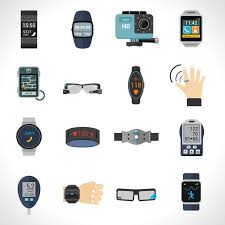The wearable technology market is rapidly growing, driven by advancements in technology, increasing health awareness, and consumer demand for convenience and connectivity. Below is an overview of the competitive landscape of the top 10 key players in the wearable technology market.
Top 10 Key Players
- Apple Inc.
- Overview: Apple is a leading player in the wearable technology market, primarily known for its Apple Watch.
- Strengths: Strong brand loyalty, seamless integration with iOS devices, and continuous innovation.
- Recent Developments: Introduction of health-focused features such as ECG, blood oxygen monitoring, and fitness tracking.
- Samsung Electronics Co., Ltd.
- Overview: Samsung offers a range of wearable devices, including the Galaxy Watch and Galaxy Fit series.
- Strengths: Diverse product portfolio, compatibility with Android devices, and innovative design.
- Recent Developments: Enhanced health tracking features and integration with Samsung’s ecosystem of devices.
- Fitbit Inc. (acquired by Google)
- Overview: Fitbit is renowned for its fitness trackers and smartwatches.
- Strengths: Strong focus on health and fitness tracking, extensive user base, and data analytics capabilities.
- Recent Developments: Integration with Google’s ecosystem, expanded health monitoring features, and new product launches.
- Garmin Ltd.
- Overview: Garmin specializes in GPS technology and offers a wide range of wearables, including fitness trackers and smartwatches.
- Strengths: Advanced GPS and navigation features, durable design, and specialized products for various sports.
- Recent Developments: Enhanced multisport tracking, improved battery life, and integration with health and fitness apps.
- Huawei Technologies Co., Ltd.
- Overview: Huawei provides a range of wearables, including the Huawei Watch and fitness bands.
- Strengths: Competitive pricing, strong battery life, and integration with Huawei’s ecosystem.
- Recent Developments: Introduction of advanced health monitoring features and AI-driven fitness insights.
- Xiaomi Corporation
- Overview: Xiaomi is known for its affordable yet feature-rich wearable devices, such as the Mi Band series.
- Strengths: Cost-effective products, strong presence in emerging markets, and large user base.
- Recent Developments: Continuous product improvements and expansion into new markets.
- Sony Corporation
- Overview: Sony offers various wearable devices, including smartwatches and fitness trackers.
- Strengths: Strong brand reputation, innovative design, and integration with Sony’s entertainment ecosystem.
- Recent Developments: Focus on enhancing user experience and expanding product features.
- Fossil Group, Inc.
- Overview: Fossil combines fashion and technology in its range of smartwatches.
- Strengths: Stylish designs, partnerships with fashion brands, and integration with Wear OS by Google.
- Recent Developments: Launch of new smartwatches with improved functionality and expanded health tracking features.
- Polar Electro Oy
- Overview: Polar is known for its heart rate monitors and fitness trackers.
- Strengths: Expertise in sports and fitness tracking, accurate data collection, and strong reputation among athletes.
- Recent Developments: Introduction of new training and recovery features, and enhanced data analytics.
- Suunto (owned by Amer Sports Corporation)
- Overview: Suunto specializes in sports watches, dive computers, and instruments for outdoor adventures.
- Strengths: Robust design, advanced sports tracking features, and strong focus on outdoor and adventure sports.
- Recent Developments: Enhanced GPS functionality, improved battery life, and new product launches targeting outdoor enthusiasts.
Competitive Strategies
- Innovation and Product Development
- Continuous innovation in health monitoring, fitness tracking, and connectivity features is critical for maintaining competitiveness.
- Strategic Partnerships and Acquisitions
- Collaborations with tech giants, acquisitions of smaller tech firms, and partnerships with health and fitness organizations help expand capabilities and market reach.
- Marketing and Branding
- Strong marketing campaigns, celebrity endorsements, and building a strong brand image are essential for attracting and retaining customers.
- User Experience and Ecosystem Integration
- Enhancing user experience through seamless integration with other devices and platforms, and building a comprehensive ecosystem around wearable devices is key.
Market Trends
- Health and Wellness Focus
- Increasing consumer interest in health and wellness is driving demand for wearables with advanced health monitoring features.
- AI and Machine Learning
- Integration of AI and machine learning to provide personalized insights and recommendations based on user data is becoming more prevalent.
- Battery Life and Design
- Improvements in battery life and innovative, fashionable designs are important factors influencing consumer choices.
- Expansion into Emerging Markets
- Expanding presence in emerging markets with affordable and feature-rich products is a significant growth strategy for many players.
In conclusion, the wearable technology market is highly competitive, with key players continuously innovating and expanding their product offerings to meet consumer demands. Apple, Samsung, and Fitbit (Google) are among the leading players, with strong focus on health features and ecosystem integration. Emerging market expansion and advancements in AI are expected to drive future growth in this dynamic market.
